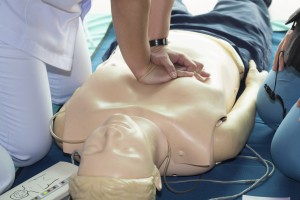How to Give Correct CPR
CPR is the abbreviation of Cardio-Pulmonary Resuscitation, an emergency first-aid technique used if someone is unable to breathe properly or if they’ve suffered a Cardiac Arrest – that is, their heart has stopped. This is truly terrifying and life threatening stuff where CPR can quite literally make the difference between life and death – if only to help keep oxygen circulating or maintain the victim’s heart in such a rhythm so that paramedics stand a good chance of a successful resuscitation.
What does CPR Involve?
Correct CPR involves giving chest compressions, applying the heel of the hand, with the other hand on top and fingers interlocked, to the victim’s breastbone and pressing down strongly with the full body weight by about 5-6cm and continuing at about 100-120 compressions per minute until the ambulance arrives. Ideally if trained and confident rescue breaths should also be given, tilting back the victim’s head, lifting the chin with two fingers, pinching the nose and blowing firmly into the mouth, then checking that the chest rises. Breaths should be given after every thirty compressions. If you’re nervous, our First Aid courses can give your staff the skills and confidence which could save a colleague’s life.
The difference CPR can make
We’ve all heard of those newsworthy cases where footballers and other high-level sportspeople have collapsed suddenly unable to breathe or in cardiac arrest. One or two – perhaps most notably Bolton footballer Fabrice Muamba - have thankfully been saved and gone on to make a good recovery. Unfortunately, it’s a tragic fact that out of hospital cardiac arrest (OHCA) rarely has a good outcome, with lack of oxygen causing hypoxic brain injuries often resulting in coma, brain damage, persistent vegetative state or ultimately, death. However, aside from those cases that make the news headlines, in 2013 alone, paramedics in England attempted resuscitation in around twenty-eight thousand cases of OHCA – and there are many, many more cases of OHCA, where resuscitation isn’t actually attempted, as tragically the victim is beyond resuscitation. The medical profession agrees that if more people had the confidence and skills given by appropriate first aid and CPR training this could be a very different story.
With people spending so much of their lives at work, and the frequency of heart attacks which can result in cardiac arrest, as well as an ageing workforce and more and more incidents of previously undiagnosed heart disorders surely it’s common sense to equip staff with the skills to at least attempt CPR? Whilst defibrillators are certainly desirable in the workplace, thorough first aid training including CPR classes should be mandatory as correctly administered CPR can, and does save lives.

Defibrillator CPR practice